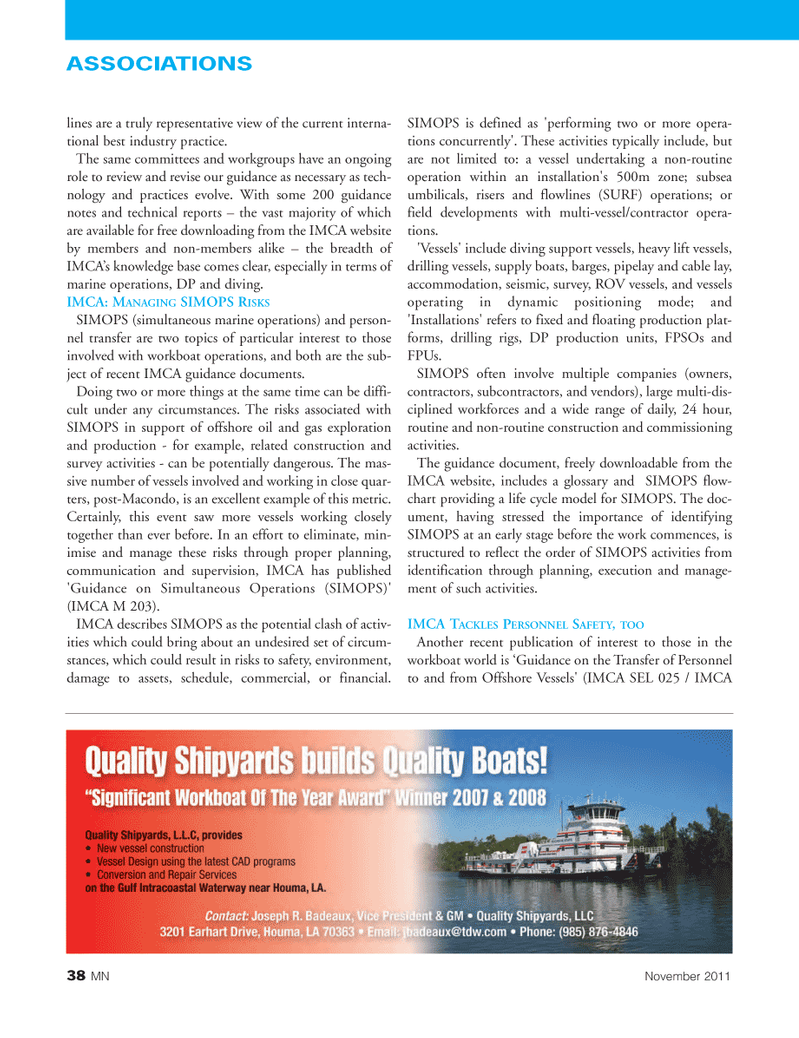
Page 38: of Marine News Magazine (November 2011)
Workboat Annual
Read this page in Pdf, Flash or Html5 edition of November 2011 Marine News Magazine
38MNNovember 2011lines are a truly representative view of the current interna- tional best industry practice. The same committees and workgroups have an ongoing role to review and revise our guidance as necessary as tech- nology and practices evolve. With some 200 guidance notes and technical reports ? the vast majority of which are available for free downloading from the IMCA website by members and non-members alike ? the breadth of IMCA?s knowledge base comes clear, especially in terms of marine operations, DP and diving.IMCA: MANAGING SIMOPS RISKSSIMOPS (simultaneous marine operations) and person-nel transfer are two topics of particular interest to those involved with workboat operations, and both are the sub- ject of recent IMCA guidance documents. Doing two or more things at the same time can be diffi- cult under any circumstances. The risks associated with SIMOPS in support of offshore oil and gas exploration and production - for example, related construction and survey activities - can be potentially dangerous. The mas- sive number of vessels involved and working in close quar- ters, post-Macondo, is an excellent example of this metric. Certainly, this event saw more vessels working closely together than ever before. In an effort to eliminate, min- imise and manage these risks through proper planning, communication and supervision, IMCA has published 'Guidance on Simultaneous Operations (SIMOPS)' (IMCA M 203). IMCA describes SIMOPS as the potential clash of activ-ities which could bring about an undesired set of circum- stances, which could result in risks to safety, environment, damage to assets, schedule, commercial, or financial. SIMOPS is defined as 'performing two or more opera- tions concurrently'. These activities typically include, but are not limited to: a vessel undertaking a non-routine operation within an installation's 500m zone; subsea umbilicals, risers and flowlines (SURF) operations; or field developments with multi-vessel/contractor opera- tions.'Vessels' include diving support vessels, heavy lift vessels, drilling vessels, supply boats, barges, pipelay and cable lay, accommodation, seismic, survey, ROV vessels, and vessels operating in dynamic positioning mode; and'Installations' refers to fixed and floating production plat- forms, drilling rigs, DP production units, FPSOs and FPUs. SIMOPS often involve multiple companies (owners, contractors, subcontractors, and vendors), large multi-dis- ciplined workforces and a wide range of daily, 24 hour, routine and non-routine construction and commissioning activities. The guidance document, freely downloadable from the IMCA website, includes a glossary and SIMOPS flow- chart providing a life cycle model for SIMOPS. The doc- ument, having stressed the importance of identifying SIMOPS at an early stage before the work commences, is structured to reflect the order of SIMOPS activities from identification through planning, execution and manage- ment of such activities. IMCA TACKLES PERSONNELSAFETY , TOO Another recent publication of interest to those in the workboat world is ?Guidance on the Transfer of Personnel to and from Offshore Vessels' (IMCA SEL 025 / IMCA ASSOCIATIONS MN#11 (32-49):MN 2011 Layouts 11/4/2011 2:13 PM Page 38

 37
37

 39
39
